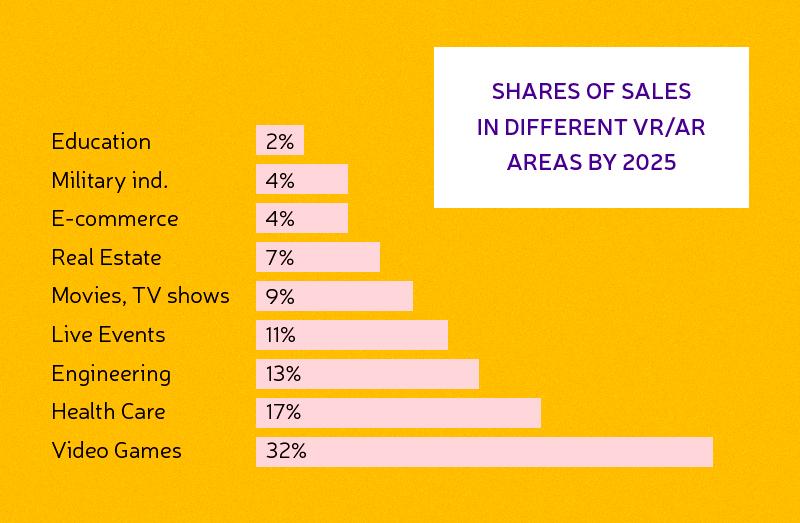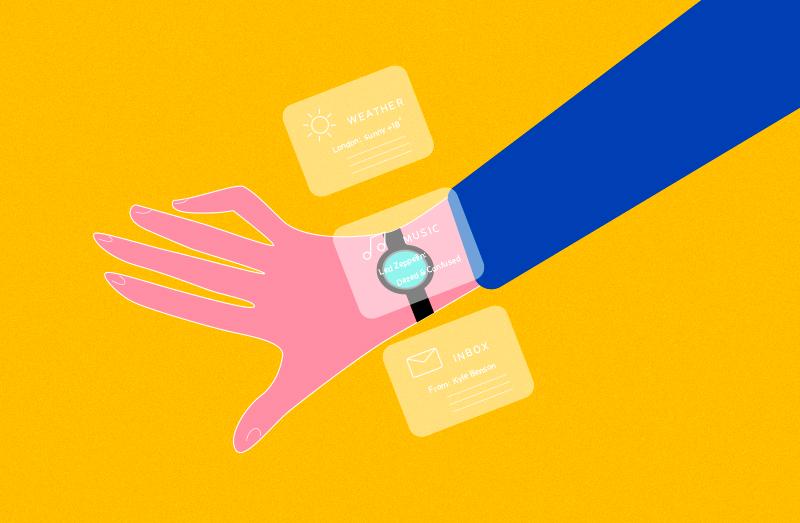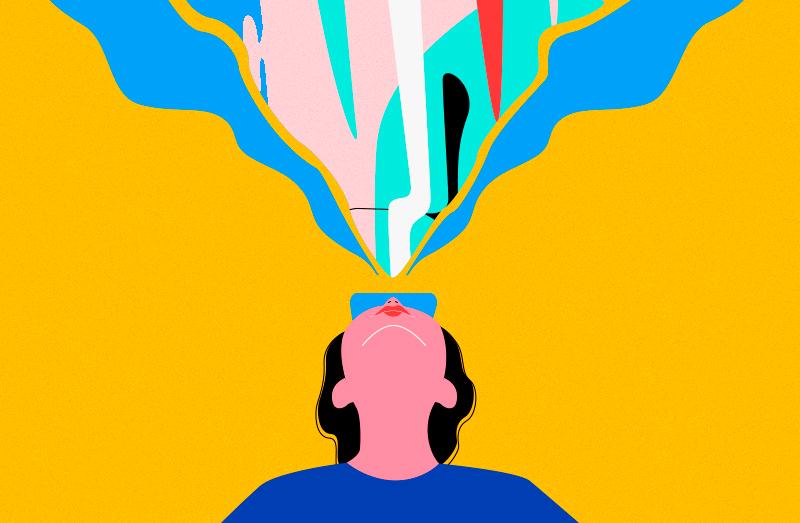Imagine you need a sofa... but here's the question: how would it look in your room? Determining if the furniture store has its own AR application is straightforward. With a few taps, your device's screen will display the desired picture.
But it’s just one of the examples of using AR technology as an effective business tool. AR changes our world for the better and covers a wide range of areas, including e-commerce, information environment, and user behavior, and it maximizes conversions.
The AR & VR market is projected to have a market volume of US$58.1bn by 2028. Moreover, Digi-Capital, the consulting company, claims that the AR market is growing four times faster than VR.
- AR enriches user experience by combining digital information with the physical environment, thereby enhancing communication, learning, shopping, and entertainment.
- The cost of developing an AR app varies from $30,000 for a simple app to over $2,000,000 for a complex application.
- Businesses embracing AR technology stand to gain an edge over their competitors by providing novel and engaging experiences that increase customer interaction and satisfaction.
So, it's time to think about introducing these technologies into your business processes. But how much does an AR app cost? We'll try to answer this question and explain all the augmented reality app development details.
What is AR?
The VR and AR concepts are not entirely new - the first funny Virtual Reality helmets appeared in the 60s of the XX century, and and augmented reality elements were developed in the 90's. AR is a technology supplementing the surrounding world with images and information created by special technical means and improves the user's immediate environment through digital data.
How does AR work?
The general scheme to create augmented reality is this one:
-
the optical scanner (camera) of the device identifies the image of the real object;
-
the device software analyzes the resulting image and selects or calculates the visible augment corresponding to it;
-
now, the real image is being combined with its augment and outputted to the visualization device. So, augmented reality has been born.
The means to create augmented reality:
-
mobile devices (tablets, cell phones);
-
augmented reality glasses;
-
TV (or computer screen);
-
a game computer such as Kinect;
-
technologies, useful if one wants to play AR in open space;
-
special means (different simulators, medical equipment).

We pay attention to the first version of creating augmented reality (using a mobile device). In this case, the mobile phone camera transmits the captured image to the downloaded application. The program recognizes the image, selects the content associated with it (text, video, 3D model), and displays the resulting picture on the device screen so that you see the effect of augmented reality.
Sometimes, you can allow a user to manage and adjust the AR object by scaling or turning it (or something of the sort). Features of augmented reality visualization are limited only by the developers’ imagination and the budget: the more demanding requests, the higher the AR app cost.
Classification of Augmented Reality Applications
There are two groups of AR applications:
-
Autonomic applications are not designed to interact with the user to get extra information. As a rule, such services provide additional data about a real-world object;
-
Interactive applications that involve interaction with the user and enable him to select the type of data to be visualized. Also, a user can change the parameters and properties of virtual objects. Such systems require input devices, such as a touch screen of mobile devices or a computer mouse.
If we talk about the degree of mobility, then the systems of augmented reality can be divided into two types:
-
stationary systems designed to work in one place;
-
Mobile systems are intended to work dynamically and with different real-world objects.
All these factors somehow affect the cost of augmented reality app development. The scope of such services is truly wide: games, animated illustrations, marketing campaigns… However, the topic deserves a more detailed discussion.
Who needs an augmented reality app development?
The promising nature of virtual reality and AR technologies is confirmed by the fact that giants like Google, Facebook, and Microsoft are paying close attention to them, and Apple is allocating huge funds for development in the field of augmented reality.

AR technologies can be used in a variety of areas: in healthcare (patient diagnosis), student education, manufacturing (modeling and product design), e-commerce (it’s a good way to stimulate sales), etc.
In other words, applications with augmented reality would bring your communication with customers to a new level and a better one. So, even the highest AR app development cost is justified and will pay off sooner or later.
#1 Entertainment industry
Speaking of the entertainment industry, we mean games in the first place (of course!). That's where there is room for imagination.
The AR app called “The Machines” is particularly worth mentioning. The Machines is a multiplayer strategy in real-time. The essence is simple: find a table, point the camera at it, and the device generates a steep post-apocalyptic location on its surface - a virtual battlefield. Next, the gamer should place his combat robots on such a map and start playing.
#2 Real estate and architecture
Augmented and virtual reality has significantly improved the quality of creation and testing of architecture, design, and construction projects.
We should mention the popular “ARki” application available for any iOS / Android device. It integrates AR technology into the architecture, creating three-dimensional models with multiple levels of interactivity for both design projects and presentations. You can use the app to put 3D models on existing two-dimensional floor plans..
If the business is related to construction or architecture, consider augmented reality app development. It is a great way to visualize the project and make it clear to the customer.
#3 Industry
The main direction of the industrial use of AR technologies is the after-sales service of manufactured products. It can provide information about the device's operation in real time and serve as a step-by-step guide to repair and manage the product based on its 3D model.
In addition, augmented reality makes it possible to visually assess an industrial product that has yet to be released. The procedure can be used to reconcile all the details with the client.
#4 Retail and E-commerce
You have an online jewelry store. Agree, it’d be smart to allow customers to try the ring on the finger virtually without the necessity of visiting the shop. Undoubtedly, such a visual expression would increase sales.
A good example is Magic Leap, which has created an AR application that allows the study of the desired product from all sides so that a shopper can see how a piece of furniture or appliance will look in the interior.
#5 Education
AR technologies have huge prospects in education, too, for studying new subjects is so much easier (and more pleasant) if you can get such great visual aids.
It would be useful to supplement the educational application with the AR feature. Of course, the cost of the augmented reality app is quite high, but the result is worth it.
#6 Advertising and marketing
More and more leading brands use augmented reality to attract additional audiences. And this is just the beginning! Imagine that in the future, you'll see only targeted advertisements that may potentially interest you: for example, when walking past a cafe, you’ll get actual information about its discounts or other offers.
If you want to advertise your product/service most effectively (so that your offer immediately catches the customer's attention), augmented reality is your best assistant. You should consider such an expenditure item as the AR app development cost.
#7 Medicine
In medicine, AR applications are no less in demand. Surgeons have already found the use of Google Glass: they’re doing surgeries with these glasses, which allow them to conduct video conferences with colleagues and summon the results of various analyses by voice order.
AR/VR technologies will help doctors see the organ under examination and monitor the dynamics of the process online. A start has been made, and all the prerequisites for evolution and upgrowth are obvious. So, it's time to think about the development of augmented reality apps.
 Find out 10 reasons why a hospital needs its application.
Find out 10 reasons why a hospital needs its application.
#8 Lifestyle
A variety of fitness and healthcare applications have gained immense popularity. That's why it's becoming more difficult to stand out among competitors. So, if you are faced with such a task and want to attract new customers to your app - use AR technology.
For example, Strava, a social fitness app, has also joined the AR boom. The service named Fitness AR, which uses Strava's API, allows athletes to visualize their path on a 3D map and mark places on it.
 Explore the real cost of fitness app development. Benefits of augmented reality app development
Explore the real cost of fitness app development. Benefits of augmented reality app development
AR contributes to promoting services and products, greatly increases user involvement in sales or entertainment, and creates an emotional connection between your brand and the consumer.
AR app development costs are justified because these unique technologies would allow to:
-
Become a market leader. Customers will see that your business is keeping pace with the times.
-
Improve interaction with customers. AR applications are a technological bonus that can become a competitive advantage for the company. This is a new and exciting experience that won’t leave users indifferent.
-
Expand marketing opportunities. The novelty, entertainment, and interactivity created by augmented reality force people to share their experiences through social networks. Such a customer reaction will greatly increase your marketing opportunities.
So, the benefits of technology are quite clear, and the question of AR app costs should no longer frighten you. But there is still a danger of competition...
 Agilie’s highly skilled experts will be able to handle the AR & VR app development tasks perfectly. Learn more about our team. Your competitors
Agilie’s highly skilled experts will be able to handle the AR & VR app development tasks perfectly. Learn more about our team. Your competitors
The AR feature is expensive and technologically complex for many brands.
Brands, including Ikea, Wayfair, and Patrón Tequila, have already taken advantage of these great possibilities by introducing new AR applications or supplementing existing services with AR features. It's time to take up the lead.
#1 Ikea
The Ikea Place application allows users to select the desired interior object from a catalog containing about 2,000 3D products based on the type of furniture or designer collections. Then, a user can take advantage of the chatbot's help to place the chosen model in the environment correctly. Of course, the service needs access to the camera to scan the floor in front of the user.
The app makes it possible to move furniture around the room virtually, change the size of objects, and offers many other useful features. Ikea thought out every detail to simplify the product selection process as much as possible.
#2 GIPHY World
The application allows beautiful GIFs to be placed in 3D space. Each AR scene gets a unique URL that can be shared with friends and edited.
The company has prepared a special set of animated images to use in augmented reality, but if you want, you can insert any picture from the site.
Undoubtedly, the owners of this service also asked themselves a question that you are worried about (how much does an AR app cost?). Fortunately, they decided the game was worth the candle, and now we can create and enjoy cool 3D scenes.
#3 CARROT Weather
CARROT Weather is a traditional weather application that has completely changed with the introduction of augmented reality. Now, users can see the current weather, weather forecasts, and other necessary data in a beautiful 3D mode.
#4 TapMeasure
TapMeasure is an application that measures various surfaces in augmented reality. With this tool, users can create a floor plan or even a 3D room model, which is then available for export to SketchUp or to other services in CAD format.
#5 Patron Tequila
The Patron Tequila company has built the free app Patrón Experience for promotional purposes. It allows users to create their agave field on any flat surface. Then, a distillery appears on the screen, and the barman tells the brand story and offers tasting notes on the selected products. The application received six five-star reviews in the App Store on the first day.
Aren't these examples of using AR technologies impressive? Then we turn to the key question, namely…
What is forming the AR app cost?
Let's look at factors determining the cost of augmented reality app development.
Platforms
Of course, ideally, the application should work on all platforms and all devices. However, the AR app development cost would be much higher in this case. Therefore, it may be wiser to act gradually, step by step.
First, analyze your customers and answer the question: what type of device do they prefer? After that, hire an augmented reality app developer who’ll create your iOS or Android mobile service (both would be the best choice, though you can always expand the coverage of your program later).
The rate of the augmented reality app development company
Since we’ve mentioned developers, let's consider that it’s the most significant pricing factor. It all depends on the rate of specialists you’ve chosen. The rate is also affected by the location.
-
USA and Canada: from $100 to $250 per hour
-
Western Europe: from $80 to $150 per hour
-
Eastern Europe: $25 to $100 per hour
-
Asia (mostly India): usually up to $ 55 per hour
The application complexity
The more complex the AR-oriented service and the more features it has, the higher the augmented reality app cost. But what should you do if your budget is limited? A good option is to create an MVP model, at least initially.
However, while simplifying the app functionality, do not overdo it, remember about the happy mean.
What must an AR application (regardless of its complexity) have?
-
Intuitive interface. Only some users will understand how to use the AR application if the service interface is poorly designed.
-
Stable work. The application should be programmed quite well to ensure that your customers only get positive emotions while using the service.
-
Quality 3d models. High-quality 3D models of your goods will increase the chances that a potential buyer will choose your product.
-
Constant updates. An AR app should be constantly updated as new products and technologies are being developed.
All this affects the cost of the augmented reality app. The more complex the design and interface, the more money you’ll spend creating it.
Actual augmented reality app development cost
Let's take a closer look at the pricing. Do you agree that it depends on the augmented reality app development hours? Hence, we should analyze this very problem.
#1 Strategic analysis of the project
This is an important preparatory stage, which is required to clarify the project's tasks. To secure both parties of the process, it is most reasonable to sign a contract, which will indicate all the details of future cooperation.
The first stage usually takes from 80 to 150 hours.
#2 Choosing SDK
Augmented reality app development requires a software library to recognize 2D markers and overlay additional content on top of a real image. Also, the important point is to support a wide range of devices, which will help ensure the application is available more readily. In other words, you need a software development kit - SDK.
The SDK is a tool designed to simplify and shorten the coding process (which would positively affect the AR app development cost).
We offer you to look at the following SDKs, the most popular ones.
ARToolKit
ARtoolKIt is a library of tracking for augmented reality with open source. Supported platforms: Android, iOS, Linux, Windows, OS X, and smart glasses.
ARtoolKit implements the following features:
-
position/orientation tracking for devices with conventional and stereoscopic cameras
-
tracking simple black squares
-
flat-panel image tracking
-
camera calibration
-
Plugins for Unity and OpenSceneGraph
-
the ability to work with optical helmets and glasses
-
free open-source software
-
sufficient speed for real-time AR applications
However, the variety of features is also a drawback of the library because it makes its integration more difficult.
Vuforia
Vuforia is one of the most popular augmented reality app development platforms.
It implements the following features:
-
recognition of various types of visual objects (cube, cylinder, plane)
-
text and environment recognition
-
VuMark (a combination of image and QR code).
All plugins and functionalities of the platform are free, but they include Vuforia watermarks. Restrictions apply only to VuMark and the number of interactions with the cloud database. A paid plan is about $ 99 per month.
Consider this when calculating the augmented reality app cost and drawing up a budget.
EasyAR
EasyAR is a simple and easy-to-use alternative to Vuforia. Supported platforms: Android, iOS, UWP, Windows, OS X, and Unity.
Version 2.0 includes the following features:
-
3D object recognition
-
perception of the environment
-
cloud recognition
-
work with smart glasses
-
cloud-based deployment of applications
The library is completely free, reducing the AR app development cost.
Kudan
According to various reviews and efficiency comparisons, Kudan is Vuforia's main competitor, and its supported platforms are Android and iOS.
Using SLAM technology, Kudan allows the recognition of simple images and 3D objects and provides easy database generation into the Unity editor.
The free version is intended only for testing applications. The cost of a paid license is $ 1,230. Kudan is easy to integrate, but, on the other hand, possible problems with the Unity editor complicate the augmented reality app development process.
Wikitude
It’s another convenient platform that supports the following platforms: Android, iOS, and smart glasses.
Wikitude has recently released a powerful SLAM solution aimed at augmented reality applications, namely Wikitude SDK 6.
Wikitude SDK 6 has the following features:
- Excellent image recognition and tracking.
- 3D tracking technology based on SLAM.
- GEO Data (improved work with georeferenced data).
- Cloud recognition.
Additional improvements:
-
Improved Extended Tracking function to save the position of the mark, even if it is outside the camera's view.
-
Advanced camera settings.
-
Increased stability of image tracking.
Wikitude offers a free trial with a watermark and full platform functionality. The price of Wikitude SDK 6 starts from € 1990. This, of course, affects the cost of the augmented reality app.
Xzimg
Xzimg represents three products that work with applications based on augmented reality: Augmented Face, Augmented Vision, and Magic Face.
Xzimg Augmented Face recognizes and tracks faces using Unity. Xzimg Augmented Vision recognizes and tracks flat images with Unity. Xzimg Magic Face is designed to replace facial features and makeup.
A free trial version is only available for demonstrations (it inverts the color and changes the image). The paid version includes all the features of the platform and costs € 1600. So, you won’t be able to cut your AR app development costs in such a case.
Maxst
Maxst offers two different tools to recognize images and environments. The database is created online through the Tracking Manager. To scan 3D objects, you should use applications on Android and iOS.
Note: Maxst works only with the 32-bit version of the Unity editor.
The free version differs from the paid one only in a watermark, so you can choose if the augmented reality app development cost issue is a matter of principle for you.
#3 App Coding Process
There are two main principles for the augmented reality app development:
-
based on the marker;
-
based on the user’s location.
No-marker technologies are often used in mobile devices and built with the help of special sensors: an accelerometer, a gyroscope, a magnetometer, and a GPS receiver. More specifically:
-
Processing of gyroscope data. This is the simplest solution for augmented reality app development. We use the data obtained through the smartphones' gyros, which allows us to form virtual models in 3D format and combine them with the surrounding reality. 250-350 hours of development.
-
GPS module. Here, advanced A-GPS technology is being used, which takes advantage of cellular communication and Wi-Fi connection, increasing geolocation accuracy.The development time takes about 550-650 hours. The AR app cost, respectively, is higher.
-
SLAM technology. SLAM means Simultaneous Localization and Mapping. The method has the highest accuracy and effectively creates 3D objects, imposing them on environmental ones. Its advantage is the ability to simultaneously use different sensors for data processing, including a gyroscope, GPS module, camera, accelerometer, etc. Of course, the cost of an augmented reality app is rather high in this very case since the development time is more than 850 hours (and sometimes more than 1000 hours).
Discussing the system of markers, such a way of augmented reality app development is quite widespread. It implies the formation of markers of different levels of complexity (the top of the line is to distinguish objects like human faces or animals).
A marker is an object located in the surrounding space, which is recognized and analyzed by special software for the subsequent drawing of virtual objects.
The main difficulty is finding the marker, determining its location in the frame, and projecting the virtual model accordingly.
Developers need about 450-550 hours to implement one of the abovementioned technologies. The more difficult the coding, the more hours specialists will spend, and the higher the AR app cost.
#4 Design Solution
Regarding augmented reality with its virtual 3D models, design becomes a top priority requiring high skill.
Usually, the design stage includes:
-
Building wireframe.
-
3D model creation.
-
UI/UX and graphic design.
-
Creation of animated images.
The time to implement this list is about 400-600 hours.
#5 Extra Features
In the process of preparing the budget and calculating your future augmented reality app costs, be sure to consider that you have to think about the functionality of your service. AR feature alone cannot meet all the needs of your user.
Of course, it is difficult to judge which features your application should have, it all depends on the nature of your business. In general, we can offer the following options:
-
Log-in (offer different ways to register through email, SMS, social media, etc.).
-
Access to phone contacts, gallery, and other smartphone resources.
-
Push notifications.
-
The Payment system, if needed.
-
Messaging feature.
-
Feedback.
Of course, this is a fairly short list; feel free to add other necessary features. But remember: your developer has to spend about 10-50 hours, sometimes more, to implement any of them.
By the way, the situation becomes even more complicated if we are talking about games with the AR effect. The cost of an augmented reality app increases because you should implement additional features such as:
-
All kinds of ratings - 25-35 hours;
-
Different sound effects – 75-85 hours;
-
Real-time gaming with multi-players – 200-300 hours;
-
Awards and achievements – 50-70 hours.
#6 Testing
The qualified QA team should carefully check your service and make sure it works flawlessly. Usually, testing takes up to 100 hours.
#7 Post-service
Of course, it’s also an important expense item. Usually, it reaches 20-50% of the AR app development cost per year.
Application support implies constant service updating, functionality expansion, improvement of work quality, etc.

So, summing up, let's say that the AR app development cost varies within the following limits:
-
Simple AR applications: $30-50 000
-
Medium-sized AR apps: $50-200,000
-
Complex AR applications (most often, games): from $ 250,000, sometimes up to $2,000,000
Agilie's expertise
Our team develops unique custom Augmented Reality apps and experiences. We cover the full development cycle: from concept to project implementation.
We offer:
-
A turnkey solution, from scratch and without templates;
-
Research of the market and competitors;
-
Forming an application structure;
-
Excellent coding;
-
Full testing process;
-
Integration of the application into your business processes;
-
Reconstruction of existing AR applications;
-
Help in placing applications in AppStore and Google Play.
Most importantly, the cost of augmented reality app development is quite affordable.

Conclusion
Both users and companies would be delighted with augmented and virtual reality: the first ones will enjoy a new vivid experience while the business owners can keep up with the times and offer advanced solutions. AR technologies have a great future, and it's important not to miss the chance to be among the leaders while it’s still possible.


